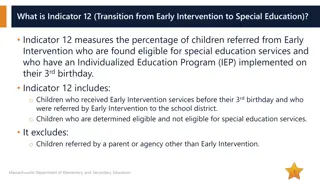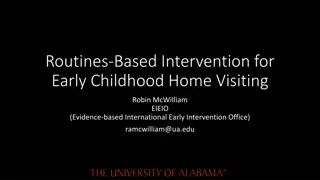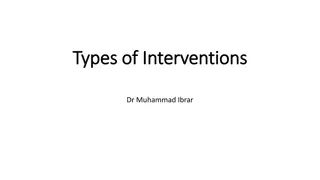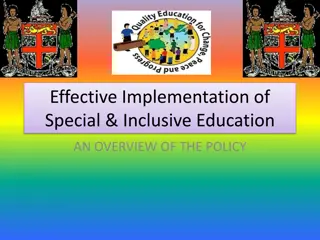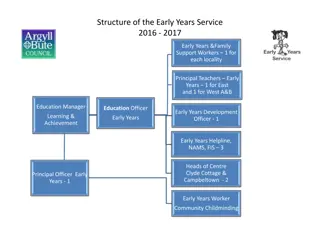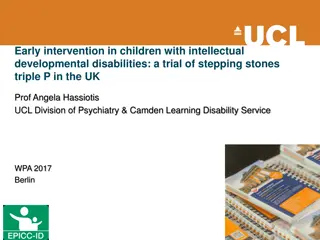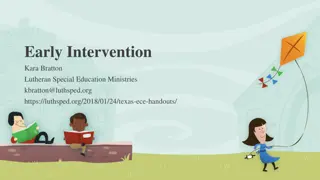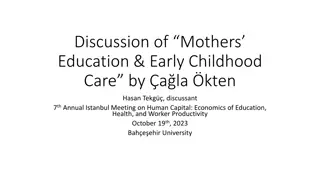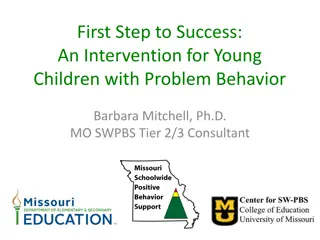Early Intervention and Teaching Strategies in Special Education
Early Intervention in Special Education involves promoting the development of children with delays or disabilities through a system of services focusing on various skills like language, cognition, and social interaction. Understanding brain plasticity, gene-environment interaction, and the importance of stimulation are key components in shaping effective teaching strategies. Compliance with Acts and Policies like PL94-142, IDEA 1990, PwDAct, and RPwDAct underscores the significance of early intervention practices.
Download Presentation

Please find below an Image/Link to download the presentation.
The content on the website is provided AS IS for your information and personal use only. It may not be sold, licensed, or shared on other websites without obtaining consent from the author. Download presentation by click this link. If you encounter any issues during the download, it is possible that the publisher has removed the file from their server.
E N D
Presentation Transcript
EDUCATIONAL INSTRUCTION AND TEACHING STRATEGIES (SBMD) B.Ed SPECIAL EDUCATION(MD) II Year P. KAMARAJ , NIEPMD ,Chennai. Kamaraj_nimh@yahoo.com , 9840380628
UNIT I : EARLY INTERVENTION Concepts , Principles , and importance of brain plasticity Teaching SHS , Feeding and Oro motor skills Multimodal approach to facilitate development of language , communication , speech , cognition ,social /emotional skills , leaning to play Teaching pre-requisite skills for reading ,writing , arithmetic and other related skills Individualised family support plan
CONCEPTS , PRINCIPLES , AND IMPORTANCE OF BRAIN PLASTICITY EXPECTED OUTCOME To understand the concepts on Early Intervention To define the term Early Intervention To describe the principles of Early Intervention To enumerate the Importance of Brain Plasticity
CONCEPT Development of a person is based on the interaction between gene and environment Development is a continuous process Insult alter or arrest the process of development Stimulation plays a major role of bring in the changes in the process of development The significance of early intervention is realised and become Mandatory to practice base on the guidelines given in the Acts and Policies such as PL94-142 1975 , IDEA 1990 , PwDAct , RPwDAct 2016
CONCEPTS Early intervention is for Early in Age Early intervention is for Early in Stage
EARLY INTERVENTION Early Intervention, or EI, refers to services used to promote the development of a child with special needs. When children are showing delay in development of self help , physical, cognitive , language , social the families are offered resources and support Early intervention is a system of services that helps babies and toddlers with developmental delays or disabilities.
DEFINITION According to Siegal (1972), Early Intervention is defined as the introduction of planned programming deliberately timed and arranged in order to alter the anticipated or projected course of development
RATIONAL The Growth and development is very rapid in the first 2-3 years of postnatal life. Most of the brain growth, motor development, language, personality, temperament, attachment, social development is achieved in the first 2 years of child s development. The first phase of cognitive development take place in 0-2 year that explained in Piaget s theory in which the basic foundations of intelligence and adaptive behavior are laid down. Factors in prenatal and early postnatal life have adverse effect which may result in impairments and disabilities and cause developmental delays or deficits in children. Early assessment and early diagnosis of all the neonates are essential to provide Early intervention
PURPOSE The purpose of Early intervention is prevention of disability and developmental delays.
MILESTONES At age one month most children can: Raise their heads slightly when lying on their stomachs Briefly watch objects Pull away from a blanket on their face At age three months most children can: Lift their heads and chest while lying on their stomachs Make cooing sounds Follow a moving person with their eyes Smile back at someone
MILESTONES At age six months most children can: Sit with minimal support Roll from their back to their stomach Respond to their name by looking At age 12 months most children can: Pull themselves up to stand and take steps with hands held Follow with their eyes in the direction that you are pointing Start a game of peek-a-boo, imitate clapping hands, point to show you something Say two or three words on a regular basis Sit up when prompted
MILESTONES At age 18 months most children can: Walk backwards Walk down stairs holding an adult's hand Use words and gestures (like taking you by the hand) to get needs met Perform simple pretend play like talking on the phone, feeding a stuffed animal
MILESTONES At age 24 months most children can: Kick a large ball Describe an injury or illness to an adult (bumped my head) Show interest in other children by offering them a toy or taking their hand At age 32 months most children can: Pretend to be an animal or favourite character Talk about the past/future Answer "what", "where", and "who" questions easily Imitate drawing a horizontal line after being shown Hold a crayon with 3 fingers
PRINCIPLES EI is to support families in training their child's developmental activities to participate in family and community program. To encourage the families to actively participate in the training program conducted by all the team members and involve them in the daily routine at home. It needs a collaborative relationship between families and service providers with equal participation
PRINCIPLES Intervention must be linked to specific goals that are family-centered, functional, and measurable. Intervention strategies should focus on facilitating social interaction, exploration, and autonomy. It shall be integrated into a comprehensive plan that encourages transdisciplinary activities. Quality service is ensured Technology should be embedded with the training Intervention should be monitored periodically to assure that the strategies implemented are successful in achieving outcomes.
BRAIN PLASTICITY Early intervention is based on the fact that the new born brain has tremendous capacity to recover from established central nervous system insult or injury. This is otherwise called as the Plasticity of the CNS. The structural and functional changes produced by endogenous and exogenous influences that may occur at any time during the individual s life history is defined as Plasticity Jennifer S.Buchwald
IMPORTANCE OF BRAIN PLASTICITY This feature is unique to the young developing brain only and gives the malleability to this period of 0-2years age This plasticity makes it possible to bring about changes and promote development towards normalcy Development is a lifelong process but the most important things are most sensitive to input early The children s brain at early stage will have the attitude to carryout the task immediately by coordinating with its existing connectivity.
CONCLUSION Early Intervention program is planned and conducted based on the developmental principles It follows certain guidelines Empowerment of Family members are become part of early intervention program The program of Early intervention is planned and given based on the program of brain plasticity of CNS
REFERENCE Peterson, Nancy L.(1987). Early Intervention for Handicapped and At-Risk Children. Denver: Love Publishing. Shonkoff, Jack P., and Samuel J. Meisels. (2000). Handbook of Early Intervention. Cambridge, Eng.: Cambridge University Press. Persha.A.J ., Rao.S. (2003).Early Intervention to IUGR. Children At-risk for Developmental Delay. NIMH , Secunderabad India.


